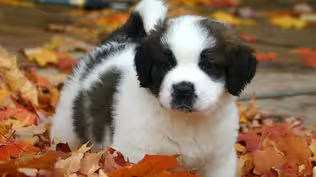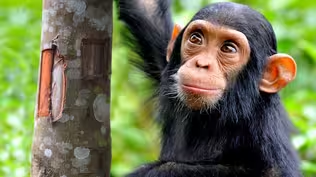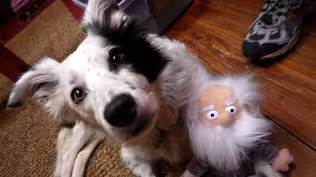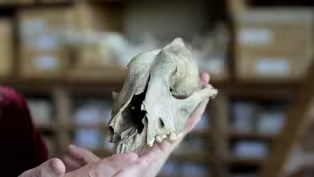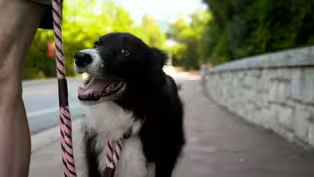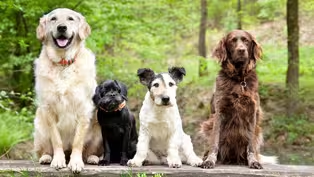
Dog Tales
Season 47 Episode 2 | 53m 21sVideo has Closed Captions
Follow the epic journey of dog domestication and see what science says about dogs’ love.
Dogs have long been dependable companions by our sides. But it wasn’t always that way, and a look at their closest living relative, the wolf, makes it clear why. Research into dog domestication and intelligence offers clues into the human-dog relationship. And analyzing dogs’ brain activity and genes may even help answer whether dogs are in it for the food—or if they really love us.
Problems playing video? | Closed Captioning Feedback
Problems playing video? | Closed Captioning Feedback
National Corporate funding for NOVA is provided by Carlisle Companies and Viking Cruises. Major funding for NOVA is provided by the NOVA Science Trust, the Corporation for Public Broadcasting, and PBS viewers.

Dog Tales
Season 47 Episode 2 | 53m 21sVideo has Closed Captions
Dogs have long been dependable companions by our sides. But it wasn’t always that way, and a look at their closest living relative, the wolf, makes it clear why. Research into dog domestication and intelligence offers clues into the human-dog relationship. And analyzing dogs’ brain activity and genes may even help answer whether dogs are in it for the food—or if they really love us.
Problems playing video? | Closed Captioning Feedback
How to Watch NOVA
NOVA is available to stream on pbs.org and the free PBS App, available on iPhone, Apple TV, Android TV, Android smartphones, Amazon Fire TV, Amazon Fire Tablet, Roku, Samsung Smart TV, and Vizio.
Buy Now
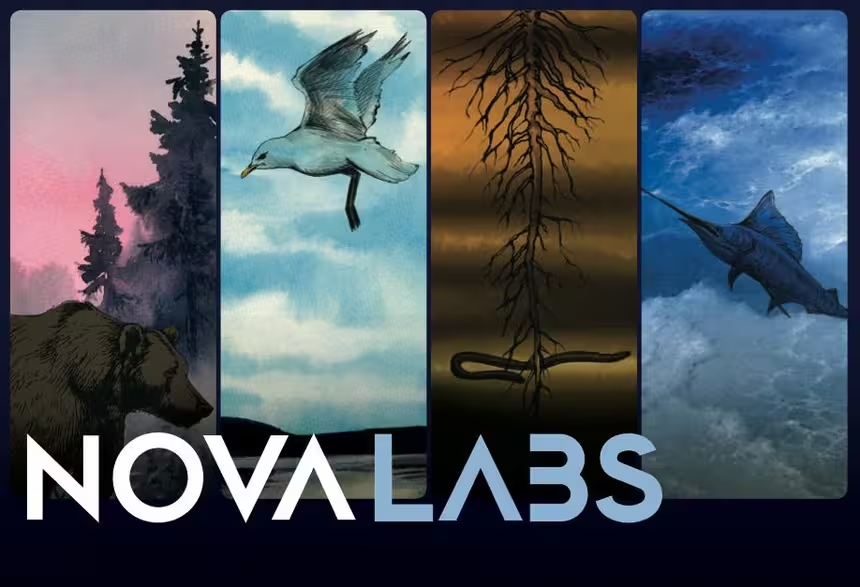
NOVA Labs
NOVA Labs is a free digital platform that engages teens and lifelong learners in games and interactives that foster authentic scientific exploration. Participants take part in real-world investigations by visualizing, analyzing, and playing with the same data that scientists use.Providing Support for PBS.org
Learn Moreabout PBS online sponsorship♪ ♪ ♪ ♪ NARRATOR: This planet is home to over a billion dogs.
So in the U.S.A., there's more than 75 million dogs alone.
(dogs barking) They're everywhere now.
(yapping) They are really special animals.
Pickles!
NARRATOR: They're more than just great pets... That's my girl.
Mm, love you, too.
♪ ♪ NARRATOR: Dogs have helped make humans better hunters.
Better farmers.
They protect people from danger.
And might even save them from themselves.
TRAINER: You can hug your dog.
The dogs change so many of them.
It's amazing.
NARRATOR: What makes dogs so special?
♪ ♪ Discoveries in genetics and behavioral science are now starting to unlock their secrets.
The last decade in dog science has been the most exciting there's ever been.
This is just the most amazing time to be a dog scientist.
(howling) NARRATOR: Where did they come from?
How did they evolve from wild beast to lapdog?
ANASTASIYA KHARLAMOVA: Fox behavior looks like dog.
It's impossible not love them.
NARRATOR: How can dogs look so different, yet still be dogs?
What lies behind a dog's affection for humans?
GREGORY BERNS: Are dogs living with us because we feed them, or are they living with us because they love us?
NARRATOR: And could the answer finally explain our species' enduring friendship?
(laughing) I feel that we've cracked the puzzle of domestication.
(barking) NARRATOR: "Dog Tales."
Right now, on "NOVA."
♪ ♪ ♪ ♪ NARRATOR: Humanity's best friend: the dog.
(dog barks) They come in all shapes and sizes.
But whatever the breed, a pooch can make you feel like a million bucks.
Hug.
Good girl.
They bring me so much happiness and companionship.
(laughs) I would dive in front of traffic for her.
I would do anything for her.
(chuckles) LEE: Dogs and humans.
We're the best duo in all of evolutionary history.
(dog barking in distance) It's humanity's oldest friend.
NARRATOR: The roots of our relationship have long been a mystery.
But now, scientists are making extraordinary breakthroughs.
BERNS: Y'all let me know when she's ready, and I'll start.
NARRATOR: They're coming to the conclusion that the bond between our species runs even deeper than we thought.
And might explain how these once-wild animals became humanity's perfect partner.
♪ ♪ It's easy to love dogs.
That's my girl.
Mm, love you, too.
NARRATOR: But how do they feel about humans?
It certainly looks like love, but could they just be in it for the food?
Seems like an impossible question to answer.
We can't ask them, but could we read their minds?
♪ ♪ Here in Atlanta, a unique experiment is underway.
♪ ♪ Kaylin is visiting Emory University.
WOMAN: Good girl, all righty.
Good morning!
Hey!
Hey, Kaylin.
Good to see you.
NARRATOR: She's part of a special project run by Gregory Berns.
I know.
Okay, yeah, so are we going to do some work today?
NARRATOR: He's attempting to resolve the biggest question about dogs.
BERNS: The party line would say that dogs, in some way, are scam artists.
That in fact the only reason that they live with us is because we feed them and because we provide shelter.
BERNS: She is ready.
BERNS: So the core of this project is the questions are dogs living with us because we feed them or are they living with us because they love us?
And to me, that's all the difference in the world.
NARRATOR: To understand just what a dog is thinking, Gregory has trained them to lie in a brain-imaging MRI machine.
WOMAN: Good girl, okay.
BERNS: You know, the traditional ways to understand what dogs are thinking is to look at their behavior.
(buzzer sounds) But the problem with that is that dogs will often do things we don't expect.
Brain imaging gets around these problems by going directly to the brain, and, in essence, bypassing behavior and go directly to the organ that causes everything to happen.
♪ ♪ NARRATOR: The dogs in the study are trained to relate toys to different outcomes.
When they see a pink car, the dogs learn to expect praise.
(exclaims) NARRATOR: When it sees a blue knight, it learns to expect some sausage.
By comparing those two conditions-- the anticipation, in particular-- to food versus human, we can go in and look at the reward system of the brain and see which one is higher or not, or they equal, perhaps?
(MRI machine humming) NARRATOR: The level of pleasure the dog experiences is determined by the amount of the neurotransmitter dopamine the brain releases, revealed on the scan by increased blood flow to specific regions.
Good girl-- stay.
BERNS: So, Laurie, if you want to fade out of view, and then we'll do the toys.
NARRATOR: Gregory has conducted this experiment on numerous dogs.
♪ ♪ And the scans are a revelation.
BERNS: So, these colored areas represent what dogs' brains do when they're anticipating food.
It actually isn't showing very much happening, which means that on average, the dogs probably didn't care as much about the food as we thought.
NARRATOR: But, when expecting praise...
The dopamine levels are regularly higher.
BERNS: Now we actually do see quite a bit of activity.
What that speaks to is the fact that praise is very interesting to the dogs.
Did they get one?
That was a good job!
NARRATOR: The brain scans show unambiguously that most dogs love praise just as much as food.
And some dogs love praise even more.
Good girl.
BERNS: Who's a good girl?
You are.
BERNS: These results show that a social bond is as strong as the food that we're providing to the dogs, and that it's intrinsically rewarding in and of itself.
And, to me, that's about as close as you can say that a dog loves you.
LEE: They are really special animals.
Our relationship from a species-to-species level just seems to be so amazing and enmeshed.
So some may ask, "How did humans ever come to find "an animal that seems perfectly fit for us?
How did they ever come to exist?"
(wind howling) NARRATOR: The answer to this canine mystery lies in the distant past, with an animal not known for friendliness.
(wolves howling) The wolf.
(howling) Folklore is filled with tales of these frightening predators.
Even today, a wolf's eerie howl can freeze blood.
(howls) Yet genetic research has revealed that all dogs originally evolved from the gray wolf... An animal that has roamed the breadth of the Northern Hemisphere for at least 300,000 years.
♪ ♪ The gray wolf may look like a modern dog, but it's a very different creature-- an apex predator... (pants) And ruthless carnivore with a bone-splintering bite.
(wolves growling, panting) So how did that... (toy squeaking) Give rise to this?
(toy squeaking) ♪ ♪ At the Royal Belgian Institute of Natural Sciences, paleontologist Mietje Germonpré oversees a collection of Ice Age wolf bones.
So, I have here a skull of a typical wild wolf.
So, it's a big skull, it's from a big animal.
And what is very special is this long, elongated snout.
Now, I will show you a skull of a modern dog.
So, you see immediately that the snout is much shorter and wider.
NARRATOR: The relative proportions of the skulls of wolves and dogs are markedly different.
♪ ♪ But in 2008, Mietje made an intriguing discovery.
She was studying a 30,000-year-old wolf skull called the Goyet skull, named after the cave it had been excavated from in the 19th century.
GERMONPRÉ: At that time, the discoverers thought it was the skull of a wolf.
But I was not very happy with that because it looked different to me.
NARRATOR: Mietje's careful measurements backed up her hunch.
This was no ordinary wolf.
GERMONPRÉ: This skull is clearly smaller than the skull of wild wolves.
The snout is wider and shorter.
More comparable to the skull of the modern dogs.
NARRATOR: The shape of the wolf skull seemed to be halfway between a wolf and a modern dog: a proto-dog.
The Goyet skull was not unique.
Hunting through other European collections, Mietje uncovered more dog-like wolf skulls, also around 30,000 years old.
Could these strange-shaped European wolves be the ancestors of modern dogs?
♪ ♪ Bones alone cannot answer that question.
Scientists would need a much more precise tool.
Oxford University is home to the PalaeoBarn DNA laboratory.
Greger Larson is the lead researcher.
LARSON: We are trying to establish a pattern through time and space of the different genetic signatures that dog populations and wolf populations have had across the world over the last 20,000 to 30,000 years.
(saw whirring) NARRATOR: Thanks to recent advances in sampling technology, forensic DNA examinations can now be conducted on prehistoric bone... (saw whirring) Allowing them to compare Mietje's 30,000-year-old specimens to modern dog DNA.
LARSON: If dog domestication took place 30,000 years ago, and there was an unbroken line between those dogs and the dogs that we currently have sleeping on our sofas, then you would expect that the genetics of those dogs 30,000 years ago would match the modern populations.
But the limited genetic information that we have from the canids that would be dogs from 30,000 years ago doesn't match modern dogs at all.
NARRATOR: Mietje's 30,000-year-old European proto-dogs appear to have left no descendants.
But Greger's team also tested samples from nearly 100 other prehistoric canids.
And in this data, they have found the earliest known ancestors of modern dogs.
LARSON: Between 12,000 and 15,000 or 16,000 years ago, we do find specimens that are starting to possess genetic signatures that match those that we find in modern populations.
♪ ♪ NARRATOR: But it isn't as simple as a single ancestral line.
They found several spread across Eurasia.
LARSON: So it looks like, within dogs, we have three geographically partitioned populations that are differentiated genetically and geographically.
NARRATOR: The three ancestral dog populations and Mietje's extinct proto-dogs do, however, share one thing in common, something that may give a clue to how dogs appeared in the first place: They were all found at sites associated with another creature-- humans.
Archaeological evidence shows that 40,000 years ago, modern humans began moving into Northern Eurasia, replacing the Neanderthals who came before them, and apparently initiating a transformation in the wolves they encountered.
GERMONPRÉ: Really, something is, was going on there.
Once modern humans arrived in Europe, we see that the wolf remains start to change.
(howling) NARRATOR: The evidence suggests dog-like wolves may have appeared several times over the thousands of years since people arrived, always in places where wolves and humans shared hunting grounds.
LARSON: The formation of a close relationship between people and wolves led to dogs, because that's what dogs are.
They are an emergent property of a very close relationship between wolf populations and human populations.
♪ ♪ NARRATOR: But how did it happen?
How does a wild animal become a domesticated pet?
The answer may be found not with lifeless bones, but with the help of one of the wolf's distant living relatives, the fox.
Almost 2,000 miles east of Moscow lies the location of a unique experiment in domestication.
On this isolated farm, Russian scientists have been breeding foxes for more than 60 years.
♪ ♪ Their aim has been to better understand the effect of human contact on wild animals.
Today, the foxes are being inspected by scientists Anastasiya Kharlamova and Daria Shepeleva.
The experiment starts with a population of untamed silver foxes.
Each one is subjected to a simple test of human toleration.
KHARLAMOVA: To understand the reaction of animals toward human, we need to open the door and try to, try to put our hand inside the cage.
Ooh.
(chuckles) NARRATOR: They are testing the strength of each fox's adrenal fight-or-flight response.
(growls) KHARLAMOVA: He afraid, but he demonstrates the aggressive reaction.
NARRATOR: The level of reaction depends on the size of the individual animal's adrenal gland.
♪ ♪ Within a population, there is always a range of responses.
This fox is calm, without any aggressive sounds.
I can touch it, and the fox doesn't bite me.
KHARLAMOVA: But this one demonstrate more fear reaction without aggressive reaction.
♪ ♪ She demonstrate some interest in moving toward me.
NARRATOR: How each fox responds determines its future.
Once a year, the foxes are bred.
Around five to 20% of the most extreme of both tolerant and intolerant foxes are chosen to seed new populations.
After just ten generations of this selective breeding, the results are obvious and dramatic.
(foxes barking softly, rattling cages) This shed contains foxes bred for intolerance.
(snarling) All of them are extremely aggressive.
This one will try to bite me.
(snaps) (screeching) (yapping) NARRATOR: The experimenters have discovered that they can create animals that are dangerously antisocial.
(screeching and yapping) But they have also discovered that if you breed foxes for tolerance, something quite remarkable happens.
(foxes yapping excitedly) KHARLAMOVA: There is population selected for tame behavior.
And the result is, the behavior looks like dog.
(talking softly) Zolotoi!
Zolotoi!
NARRATOR: Their adrenal reaction is markedly subdued.
♪ ♪ They are now as relaxed in human company as a household pet.
All of them love people.
Love all people.
NARRATOR: They even wag their tails.
It's impossible not love them.
♪ ♪ NARRATOR: The experiment suggests that by selecting for human toleration, in just a few generations, a wild animal can be made to behave just like a domestic animal.
But that's not all.
We select our foxes only for behavior, but it's interesting that after the selection, we have a lot of morphological changes.
Such as... For example, a lot of white in her fur color.
This fox has a white nose, white belly, white legs, and white necks.
NARRATOR: Some foxes even develop curly tails.
Curly tails and white patches are both often seen in other domesticated animals.
What's great about that experiment is that what it demonstrates is that by a continued very strong selection for a behavioral trait, that you can then get an increase in frequency of a wide range of other traits that were not being selected for at all.
What that suggests is that there's a lot of linkages between the overall shape and size and way in which the animal is put together from an anatomical perspective and the way that it behaves.
NARRATOR: Some believe this combination of behavioral and physical changes is part of a domestication syndrome, probably caused by a genetic mutation that reduces the effect of special neural crest cells.
During development, these multipurpose cells control the ultimate size of the adrenal gland, determining how friendly the animal will tend to be.
But the same cells also affect the size of the face and legs, rigidity of the ears and tail, and the extent of color in the coat.
Select for friendliness, and every other quality can be affected, as well.
The experimental methodology has been challenged recently, but it's now widely accepted that selection for behavior can rapidly domesticate a wild animal.
(wind howling) But in the journey from wolf to dog, who made that selection?
Most scientists now believe it was the wolves themselves.
Wolves are extraordinarily adaptable.
Different packs specialize in hunting different types of prey.
It's thought that when humans first arrived, some packs may have adopted a novel survival strategy.
It's not crazy to think that there may have been a population of wolves that found themselves attracted to people and started following people in the same way that other wolf populations have started following caribou.
NARRATOR: Rather than hunting, these wolves would thrive by scavenging close to human encampments.
But only the boldest would hang around for long.
These adventurous wolves would breed, and over generations, evolve into an increasingly human-tolerant subspecies: the domestic dog.
Survival of the fittest turned out to be survival of the friendliest.
♪ ♪ Over the last 15,000 years, dogs have taken on all shapes and sizes.
At this show in North Carolina, there are dogs of every sort.
Wow.
NARRATOR: Veterinarian Debbye Turner is fascinated by this variety.
Hey, look at that!
(laughing) That's the occupational hazard.
(laughing) TURNER: Domesticated dogs have been around for thousands of years.
And they all come from their wolf ancestor.
And when you think about that, that's just absolutely incredible-- that a big old, um, Irish wolfhound comes from the same ancestor that a little tiny Maltese comes from.
NARRATOR: So what did the first dog, the ancestor of all these animals, look like?
To find out, geneticists have been decoding the dog family tree.
Their results show that some lineages split away more than 5,000 years ago, creating descendants who today may reflect the appearance of the original dog.
The Japanese Akita is one of these ancient breeds.
TURNER: These dogs separated from the genetic line very early on.
They are called a Spitz-type dog, which means they have retained many of the characteristics, the physical characteristics, of their wolf ancestors.
So they have a wedge-shaped head.
They've got these pointy pricked ears, they have a double coat, and the curled tail over their backs.
NARRATOR: Sharing the same curly-tailed trait is the venerable African Basenji.
Basenji is the granddad of ancient dogs.
However, they're not that trainable.
They will not do obedience tricks like other breeds.
Come back here.
And here's an example!
(laughs) NARRATOR: There's something else very wolf-like about a Basenji.
(howling) Its yodel.
These breeds reveal much about how dogs may have appeared and acted after they first transitioned from pack hunters to scavengers.
(howling) And provide clues as to why they may have first appealed to humans.
TURNER: You won't see Basenjis doing tricks.
But because of their closeness to their wolf ancestors, they, um, are considered very adept hunters.
LEE: As dogs were evolving from wolves into truly domesticated dogs, their traits began to change.
They were smaller, their snout length changed, the strength of the muscles that support the jaw change, even the strength and size of their teeth.
So they lost the ability to take down big prey.
But they didn't lose everything.
Dogs are still the standard bearers when it comes to detecting things with their nose.
♪ ♪ NARRATOR: A dog's nose contains 50 times the number of olfactory sensors as a human nose, giving them a sense of smell 100,000 times more acute.
Combined with sharp sight and hearing, superb stamina, and a docile temperament, for humans, they were a ready-built hunting companion.
♪ ♪ The reason why the relationship between dogs and humans in a hunting situation is so perfect is because they complement one another.
The dogs are the chasers, the humans are the finishers.
(laughs) ♪ ♪ NARRATOR: 15,000 years ago, the first working partnerships were formed.
♪ ♪ Over the following millennia, humans would breed dogs to take advantage of their wolf-like abilities.
But those selections cannot explain the extreme variety of body shapes we see today.
Instead, the genetic studies indicate that a sudden explosion of diversity in shape and size can be traced to a breeding craze that began in Europe just a few hundred years ago.
The very first kennel club was established in 1873 in England.
And it's from there that we get the vast majority of the varieties and the breeds that we see today.
♪ ♪ NARRATOR: Kennel clubs were breeding organizations originally meant to preserve local dog characteristics.
But members began to select and share dogs with extreme traits to an extent never attempted before.
♪ ♪ Geneticists have discovered that as a result of this intensive breeding, the look of Western dogs has become controlled by just a handful of extremely potent genes.
In a human, over 100 genes will determine a few inches' difference in a person's height.
But in a dog, just seven super-selected genes now control the size difference between the smallest and the largest.
In nearly all breeds, just one gene is responsible for short legs.
♪ ♪ And mutations in just three genes express the majority of coat types, from smooth... To long-haired... ♪ ♪ To whatever this is.
(barks) ♪ ♪ So, most dogs today look the way they do because of intensive human breeding for novelty.
♪ ♪ But people still value dogs not just because of how they look, but because of what humans can do with them.
♪ ♪ ♪ ♪ For thousands of years, the dog's natural instincts were exploited to help humans hunt, herd, and protect.
♪ ♪ But in the last century, their roles have multiplied.
Dogs are amazing.
We can train them to do a variety of tasks.
♪ ♪ So from very simple ones that amuse us to very useful things.
You're not going to have a cat at airports sniffing out drugs or a horse telling you that you're about to have a seizure, but dogs are able to do this in a way that just vastly supersedes any other animal, and I think that's what makes them special.
♪ ♪ NARRATOR: So what is the source of a dog's amazing ability to learn?
♪ ♪ ♪ ♪ Animal behaviorist Clive Wynne is obsessed with understanding what's going on in a dog's head.
WYNNE: Most psychologists study the minds of people.
I became fascinated in the minds of everything except people.
And so I became very interested with dogs, and very, very quickly, I became totally, totally grabbed by this amazing animal.
♪ ♪ They're absolutely fascinating-- their minds, their intellects, their cognition.
♪ ♪ Zaph... Go.
Good girl.
NARRATOR: For many years, scientists have believed that dogs are great learners because they possess an almost unique intelligence.
One key proof was their skill at the pointing test.
Okay, Zaph... ♪ ♪ Oh, what a clever doggie.
What a clever doggie-- well done.
WYNNE: Most pet dogs most of the time will follow a human point.
It seems quite undramatic to us because we're used to it, but actually, it turns out that not very many animals will do this.
♪ ♪ Okay, you ready?
NARRATOR: Even our closest primate cousin, the chimpanzee, will struggle with this test of intelligence.
♪ ♪ But are their exceptional smarts really what makes dogs so special?
♪ ♪ Maybe the answer lies in the minds of their ancestors.
(wolves howling) In the woods outside Vienna, Austria, Friederike Range is taking her wolf for a walk.
(clicks tongue) NARRATOR: Here at the Wolf Science Center, they're carrying out cutting- edge research on wolf cognition.
♪ ♪ Sit!
You're ready to go.
♪ ♪ NARRATOR: The center's 15 wolves have been brought up by humans.
RANGE: I know Aragorn 11 years and three months.
So I hand-raised him and his other pack-mates.
♪ ♪ NARRATOR: Alongside its wolves, the center raises a group of dogs, giving both sets of animals an identical amount of human contact.
We bring up the wolves and the dogs in the same way.
So they have the same experience, and this is really crucial if you want to compare them, and compare their behavioral cognition.
♪ ♪ NARRATOR: Friederike's team conduct identical intelligence tests on their dogs and wolves.
CAROLINE RITTER: We just get it there.
RITTER: Yup, and now it's working.
So what we are doing here is testing cooperative abilities in our dogs and wolves.
For this, we have this table.
♪ ♪ NARRATOR: The food on the table can only be reached if both ends of the rope are pulled at the same time.
So the animal must understand that it has to cooperate with a human partner.
♪ ♪ This dog shows how it's done.
Waiting for the human, he executes the task to perfection.
RITTER: That was nice!
♪ ♪ NARRATOR: But what about a wolf?
♪ ♪ He's actually waiting!
♪ ♪ Perfect!
♪ ♪ NARRATOR: For years, it was thought wolves were incapable of making the cognitive leap necessary to work with humans.
But these experiments are proving the opposite.
♪ ♪ And this result is not unique.
The team's work is showing wolves can be highly intelligent in multiple ways.
(laughs): I don't think that a dog is smarter than a wolf.
I think most of our studies show that actually, the wolves are much smarter.
♪ ♪ NARRATOR: Wolves have even been shown to match dogs at the pointing test.
♪ ♪ So, despite appearances, hanging out with humans did not improve the dog's raw intelligence.
WYNNE: This ability is not something that developed in dogs during the process of domestication.
It was already latent in the wolves from which all of our dogs are descended.
WOMAN: Good boy, scoot forward!
NARRATOR: If dogs are no more intelligent than wolves-- then why is a dog more trainable?
♪ ♪ Some think it may all be a matter of attitude.
For Clive, the mindset of his pet dog Zaphos holds a clue.
WYNNE: I could tell straightaway that Zaphos wasn't smart.
She's not a super-intelligent dog.
But there was something remarkable about her.
And that was so obvious once I saw it-- this ability, this capacity, this desire to form strong emotional bonds.
That she's always trying to make friends.
That she's extremely loving.
And I began to wonder, could this be the crux ability that has made dogs so successful?
NARRATOR: To demonstrate his theory, Clive uses a simple test.
It's called the circle test.
It quantifies how socially engaged an animal is.
♪ ♪ The animal is placed in a room with a human for two minutes.
An observer totals the amount of time the animal spends inside the circle, near the person.
Paired with their owners, dogs spend upwards of 60% of their time inside the circle.
Even with a stranger, Zaphos stays close for over half the time.
♪ ♪ Dogs just seem to like people.
But wolves behave differently.
This is not a lab environment, but the results from this circle test are still clear.
This young woman was involved in raising this wolf.
They've known each other all the wolf's life.
And, uh, nonetheless, the wolf doesn't spend so much time inside this circle as a dog would do.
♪ ♪ The wolf spends even less time with its handler than a dog would with a stranger.
WYNNE: The fact that the wolf doesn't want to spend as much time inside the circle with the person shows us that the wolf doesn't have that same intense level of social connection with people as a dog can have.
♪ ♪ NARRATOR: To those who know wolves well, this is no surprise.
RANGE: A dog you can usually always get to do what you want.
The wolves could care less.
They do it as they want to do it, and you can work really hard to convince them, and sometimes, you are successful.
But if they don't want to, there's nothing you can do.
♪ ♪ NARRATOR: Dogs inherited their intelligence from their wolf ancestors.
But they've also evolved a strong desire to bond with humans that makes them uniquely trainable.
Yes, good girl!
LEE: Often, in working dogs, what makes them good?
It's a partnership.
Good girl!
That dog and that human that it cares about-- they're the unit.
The unit is the person and the dog together.
♪ ♪ NARRATOR: But the dog's desire to bond is not just the key to incredible feats of learning.
This bond also appears to be unusually powerful.
♪ ♪ So much so, that here in California, it's being exploited to provide a novel pathway for human rehabilitation.
♪ ♪ Meet Max.
Max, good job.
NARRATOR: He's part of a groundbreaking program using dogs to transform the behavior of individuals who are a danger to society.
♪ ♪ (P.A.
running in background) Ready to go in?
NARRATOR: Max will ultimately be a service dog.
But much of his training takes place behind bars, at this prison facility in California.
♪ ♪ He will be in the care of long-term inmates convicted of serious crimes, from armed robbery to murder.
Many are repeat offenders.
Some, like Gerry Castillo, arrived in prison with deep-rooted psychological struggles.
Hi, how are you?
Good, how are you?
Good.
CASTILLO: I spent a lot of time by myself.
I had issues of, uh... Say, uh... Low self-esteem.
You know, low confidence.
I was antisocial.
NARRATOR: The prison environment only seems to make these problems worse.
It's in a place where you don't have feelings.
Everything is shut off.
People don't talk about emotions unless it's anger.
(people talking in background) NARRATOR: Statistically, over half of all prisoners in the U.S. will reoffend on release.
♪ ♪ Some prisons seek ways to reverse that trend.
And in this facility, that means dogs.
One wing has been transformed into a virtual kennel club.
♪ ♪ The prisoners here are each responsible for a dog.
Man and animal live together 24/7.
I got to get up in the mornings and feed him, and train him, and take him out to potty, and just care for him the whole day.
Even if I'm having a bad day.
♪ ♪ TRAINER: Just start making a big circle.
NARRATOR: Max's time inside will help transform him into an elite service dog.
Just make, keep going, circle.
NARRATOR: But it's the transformation in the inmates that seasoned prison staff find most remarkable.
Leave your dog on a sit-stay.
TINA MORONES: It's amazing.
Max!
Come here!
MORONES: It, it has changed so many of them.
Good boy.
It's wonderful to see the caring attitude that goes to it, the gentleness that's put forth through and for the dogs.
♪ ♪ You wouldn't expect to see that on the streets.
I see it here firsthand.
TRAINER: Good, Gerry!
CASTILLO: He is my friend.
You know, he makes my day.
We bonded.
He knows me better than me.
I want you guys to sit down first and lure them over your legs.
CASTILLO: By getting a dog, it's like I'm back with a family member.
I can actually interact with somebody and share my feelings with somebody.
You could hug your dog.
CASTILLO: Max has lifted my self-esteem, gave me a purpose to... to do... to do things for someone else.
TRAINER: They should be nice and calm.
NARRATOR: There is mounting evidence that even with convicts, the profound relationship between dog and man can change their whole outlook on life.
TRAINER: Good.
MORONES: Since this program has started, I've had six inmates who have left on parole and they have not come back.
They have not hurt anybody else.
They are still maintaining their lives on the outside.
TRAINER: Now let's do another nice little jog.
MORONES: This program taught them that there's more to life than just themselves.
♪ ♪ LEE: Giving people who, by some standards, have been written off as unlovable, and to have them have the opportunity to love and be loved unconditionally by this amazing creature that loves to be loved, that is loyal, that wants to please you-- I love the idea of these programs.
NARRATOR: A dog's uniquely strong desire to bond may be particularly beneficial to humans.
But dogs seem quite happy to spread the love beyond us.
WYNNE: What makes dogs special is, dogs can form very strong loving connections to members of any other species.
Never mind other members of their own species, any other species.
NARRATOR: Dogs appear to be not just loving, but almost indiscriminately affectionate.
New research suggests that this could be partly because dogs get flooded with the "love hormone" oxytocin.
♪ ♪ And the reason for that may lie partly with some very special genes.
(dog barking in distance) Hi!
TABITHA TRUELOVE: How are you?
Nice to finally meet you!
Come on in to our humble home!
Hi!
Welcome!
TABITHA: Okay, you ready to make some doughnuts?
Let's cook her up, sister!
Cook her up.
Okay, you got it, girl.
NARRATOR: 16-year-old Callie Truelove lives with Williams syndrome, a debilitating genetic condition affecting one in 10,000 people.
Two-thirds cups of water.
This is gorgeous water.
♪ We're gonna whisk it, whisk it ♪ NARRATOR: It's caused by alterations in around 30 genes, generating multiple developmental problems and learning challenges.
TABITHA: I'm going to put them in the oven.
CALLIE: There ain't nothing like Southern-style cooking.
♪ ♪ NARRATOR: But through it all, Callie radiates an incredible warmth towards the people around her.
♪ ♪ TABITHA: She just loves people.
From the time she was able to go to somebody by herself, she's always been very friendly.
Yes, let's do it!
(exclaims): They're so gorgeous!
CALLIE: And I love each and every single human being on this whole entire world.
If I could just hug all of them at once, I would, 'cause I love them so much.
CALLIE: Here's what you're gonna do, you're gonna take a doughnut... KEITH TRUELOVE: She absolutely does love every single person that she meets.
I've pastored a church for 20 years, and Callie has reached more people just with her everyday life than I possibly could in a lifetime.
I think you should have this guy.
NARRATOR: Callie's hyper-sociability is a side effect of her condition, tied to changes in three genes, one of which supercharges oxytocin levels.
Mm-mm!
Mm-hmm.
We got a pet down here.
NARRATOR: Surprisingly, people with Williams syndrome may not be the only ones affected by these altered genes.
♪ Oh, Doodle ♪ (Callie makes kissing sounds) (clapping) This is my service dog, Doodle Dandy.
♪ ♪ And he's my heartbeat.
He's my sunshine.
And I can't imagine my life without him.
Good boy.
CALLIE: He's helped me through a whole lot and he's just the best dog in the whole wide world.
And I ain't ashamed to say it.
(chuckles) ♪ ♪ NARRATOR: New research suggests that Callie and Doodle Dandy share more than just a friendship.
♪ ♪ Geneticists working with Clive have recently discovered the same rare mutations that cause Callie's hyper-sociablity are present in the dog genome.
But they are not found in wolves, suggesting these rare mutations were acquired by dogs during domestication.
WYNNE: What causes dogs to be so much more sociable, so much more socially engaged and desiring loving relationships than are wolves are due to three of the genes that are involved in Williams syndrome.
I feel that we've cracked the puzzle of domestication.
We've identified in the genetic material what it is that makes dogs so unique, and makes them so special and so successful.
NARRATOR: More research is still needed, but these rare mutations may prove to be the secret source of the unshakable bond between our two species.
CALLIE: I think that's brilliant, because I knew when he was little he had my personality, but I didn't know we shared the same gene, almost.
So that, that is so cool.
I promise I'm always going to be here for you no matter what-- through thick and thin.
♪ ♪ NARRATOR: Dogs and humans have been on quite a journey.
(wolves howling) A natural instinct to exploit their new human neighbors led wolf evolution from vicious predator to docile companion.
♪ ♪ Humans have tinkered with them through selective breeding, perfecting useful instinctual traits and playing with their looks.
♪ ♪ And it seems like somewhere along the way, we bred in an extreme motivation to learn extraordinary skills.
Because we bred in the most important trait of all.
TRAINER: You can hug your dog... LEE: The discovery that dogs experience love, that's why they're so perfect.
Are you the most beautiful dog?
That's the thing that explains not only how dogs became so domesticated, but explains why they're man's best friend and why we've been together for 15,000 years.
Who knows you better than your best friend?
(laughs) (laughing) ♪ ♪ ♪ ♪ ♪ ♪ ♪ ♪ ♪ ♪ ♪ ♪
Can Bones Reveal How Dogs Evolved from Wolves?
Video has Closed Captions
Clip: S47 Ep2 | 5m 12s | Learn more about the evolution of our furry companions. (5m 12s)
Do Dogs Love Us or do They Just Want Treats?
Video has Closed Captions
Clip: S47 Ep2 | 3m 59s | It's time to learn the truth once and for all. (3m 59s)
Video has Closed Captions
Preview: S47 Ep2 | 26s | Follow the epic journey of dog domestication and see what science says about dogs’ love. (26s)
Providing Support for PBS.org
Learn Moreabout PBS online sponsorship
- Science and Nature

Capturing the splendor of the natural world, from the African plains to the Antarctic ice.













Support for PBS provided by:
National Corporate funding for NOVA is provided by Carlisle Companies and Viking Cruises. Major funding for NOVA is provided by the NOVA Science Trust, the Corporation for Public Broadcasting, and PBS viewers.


